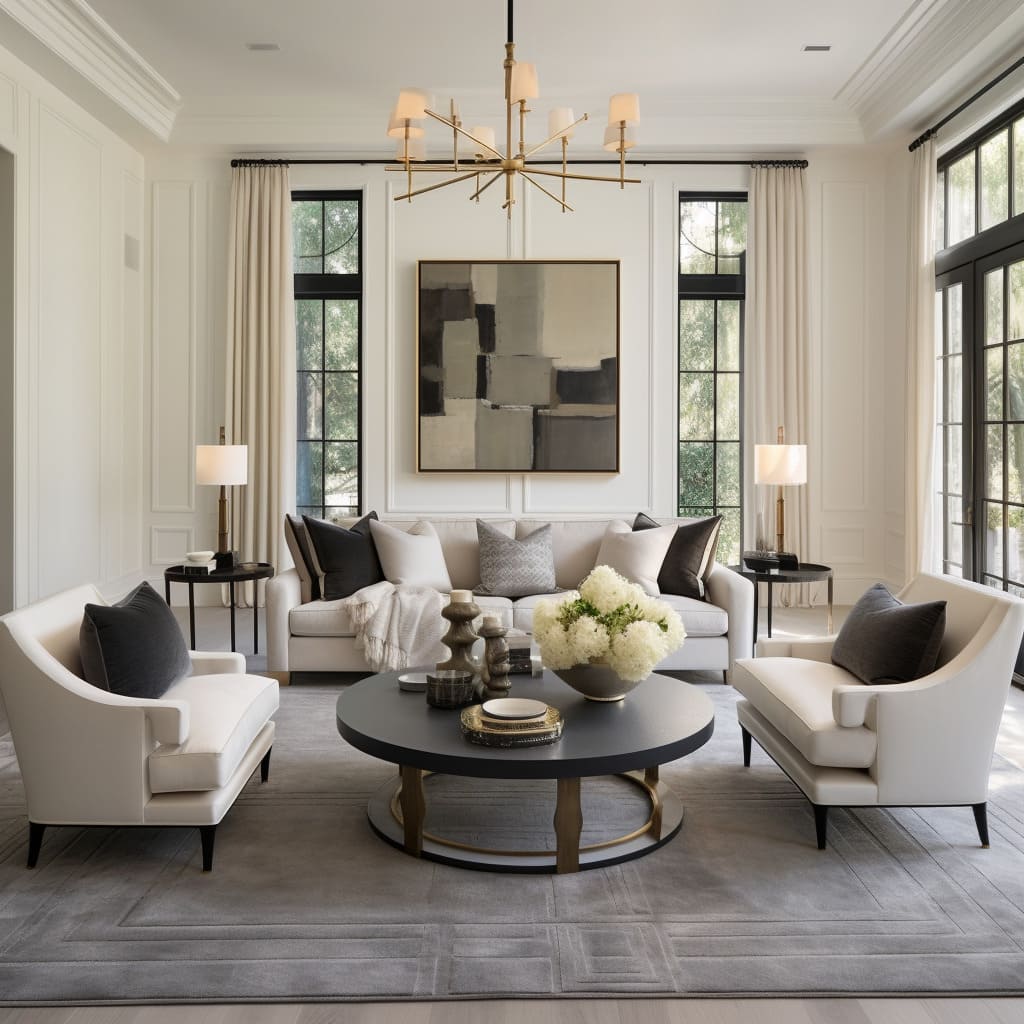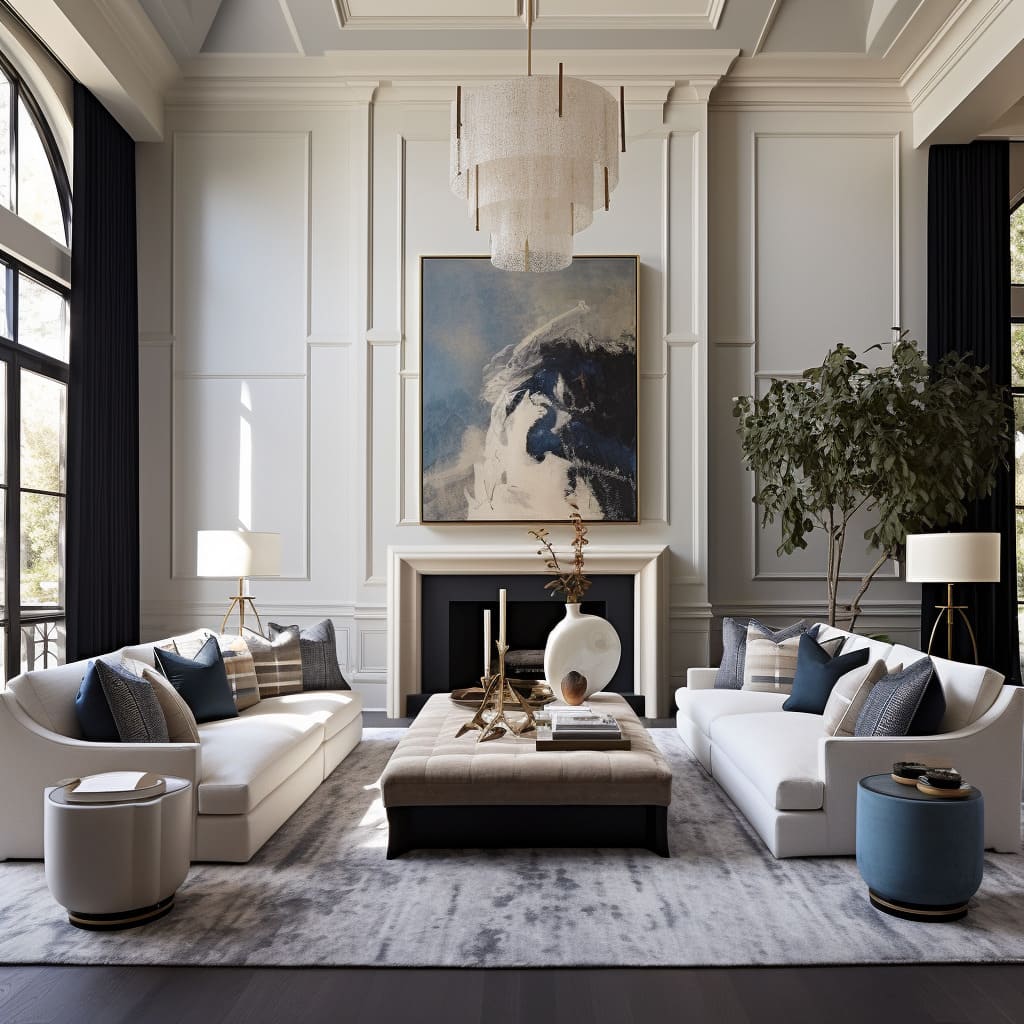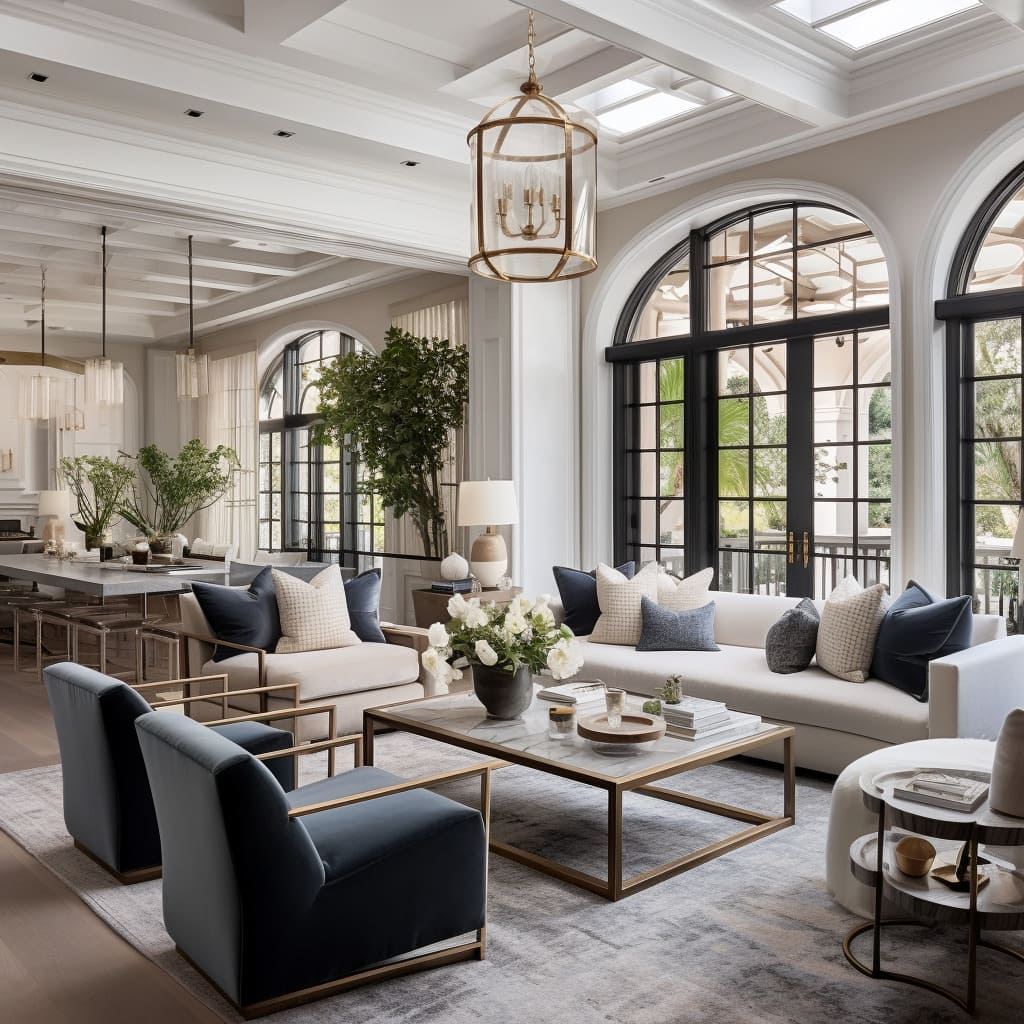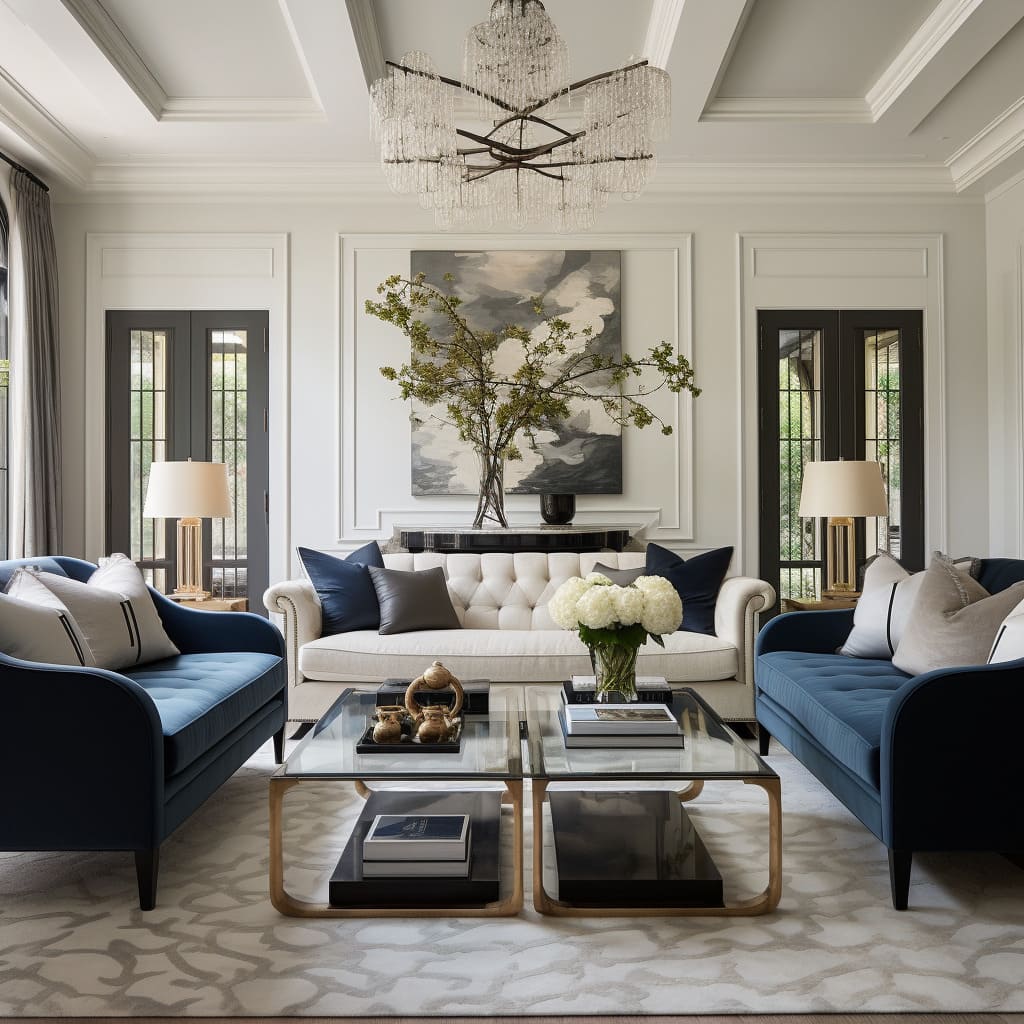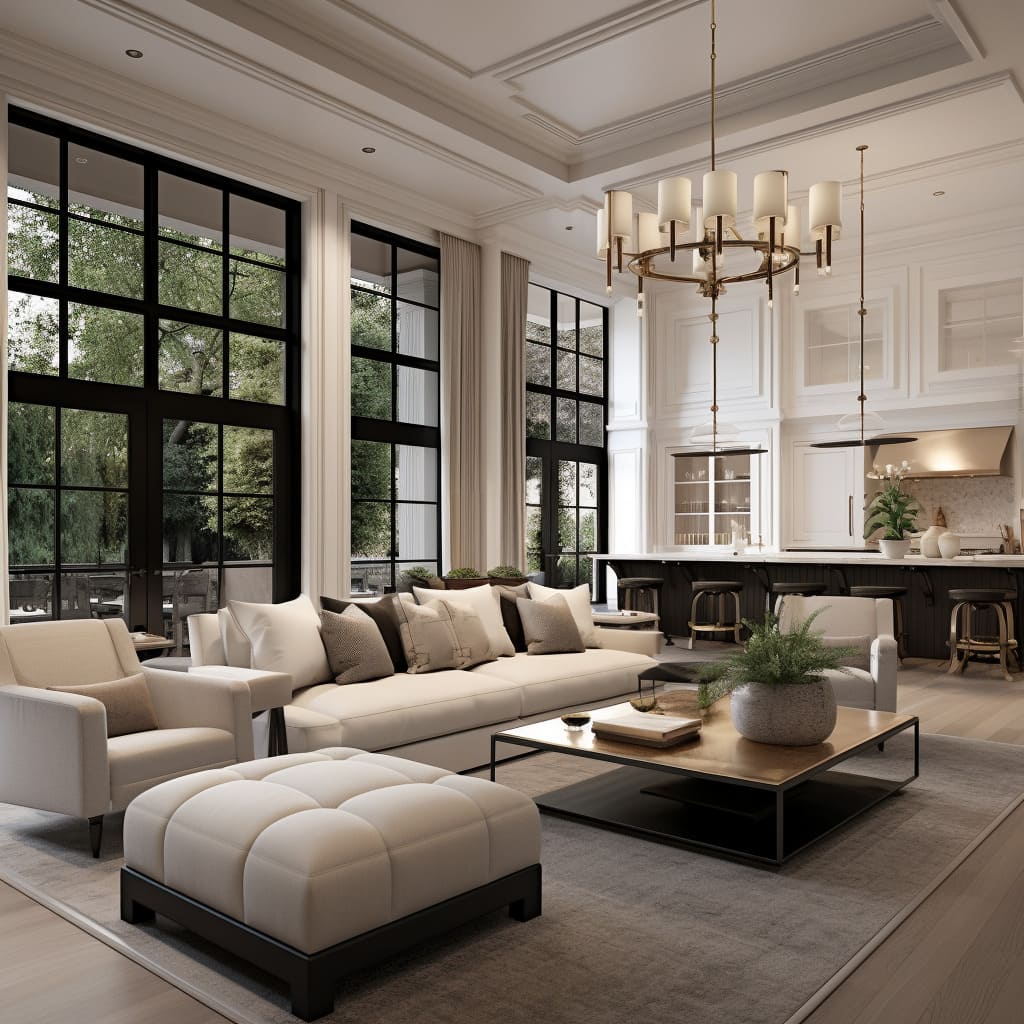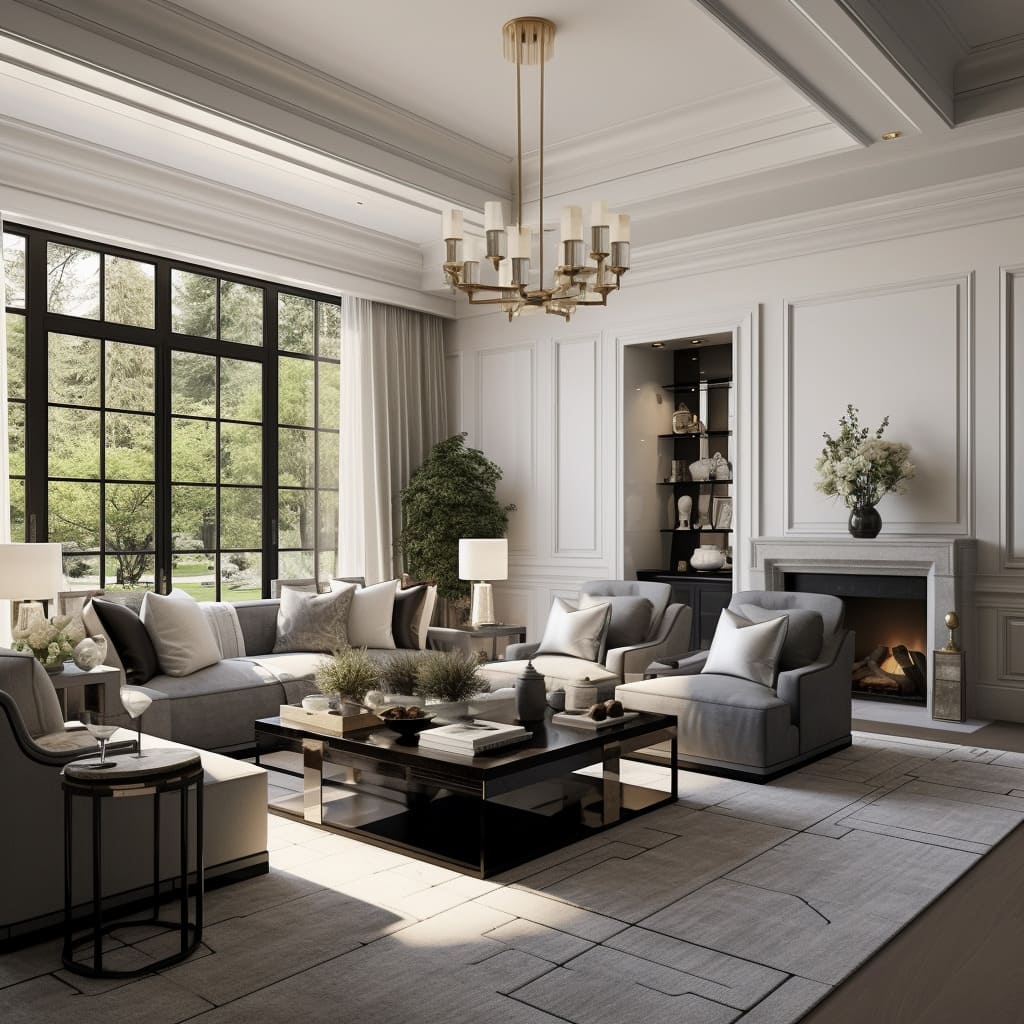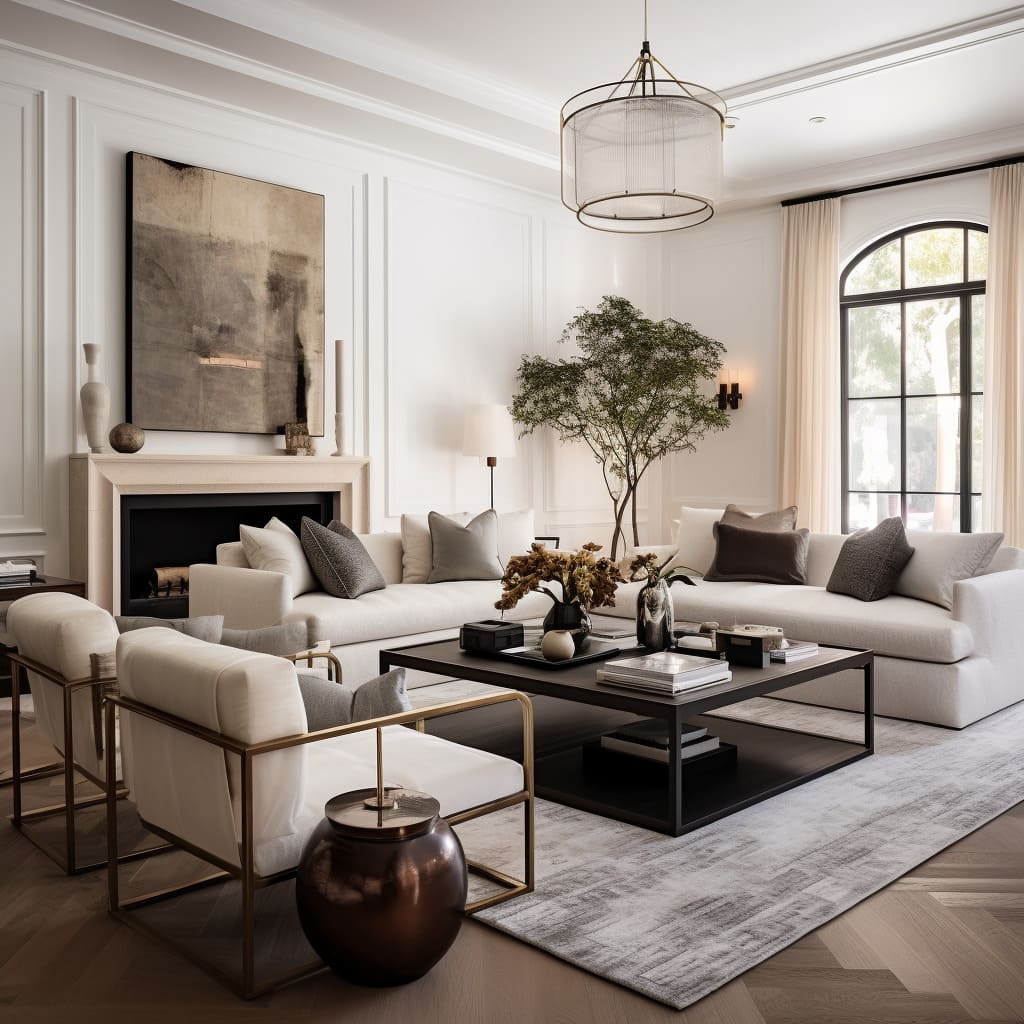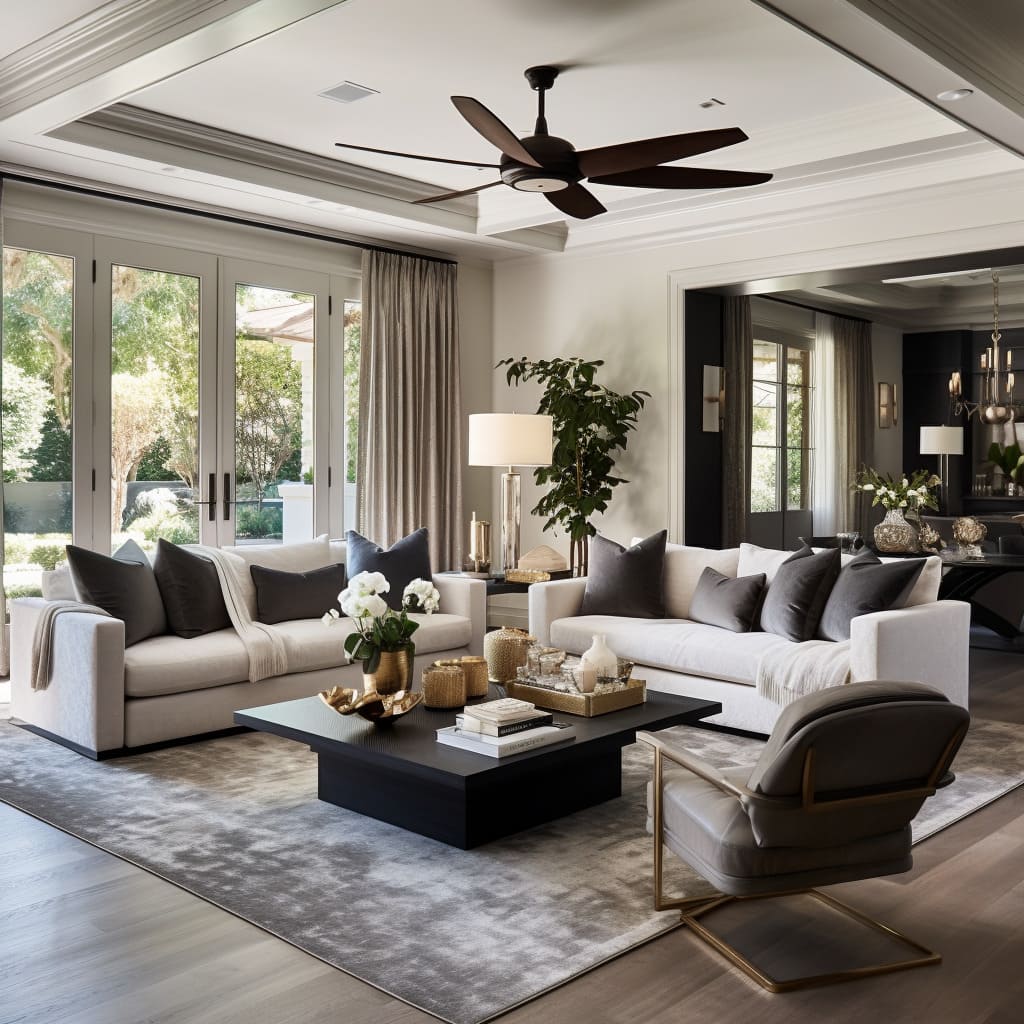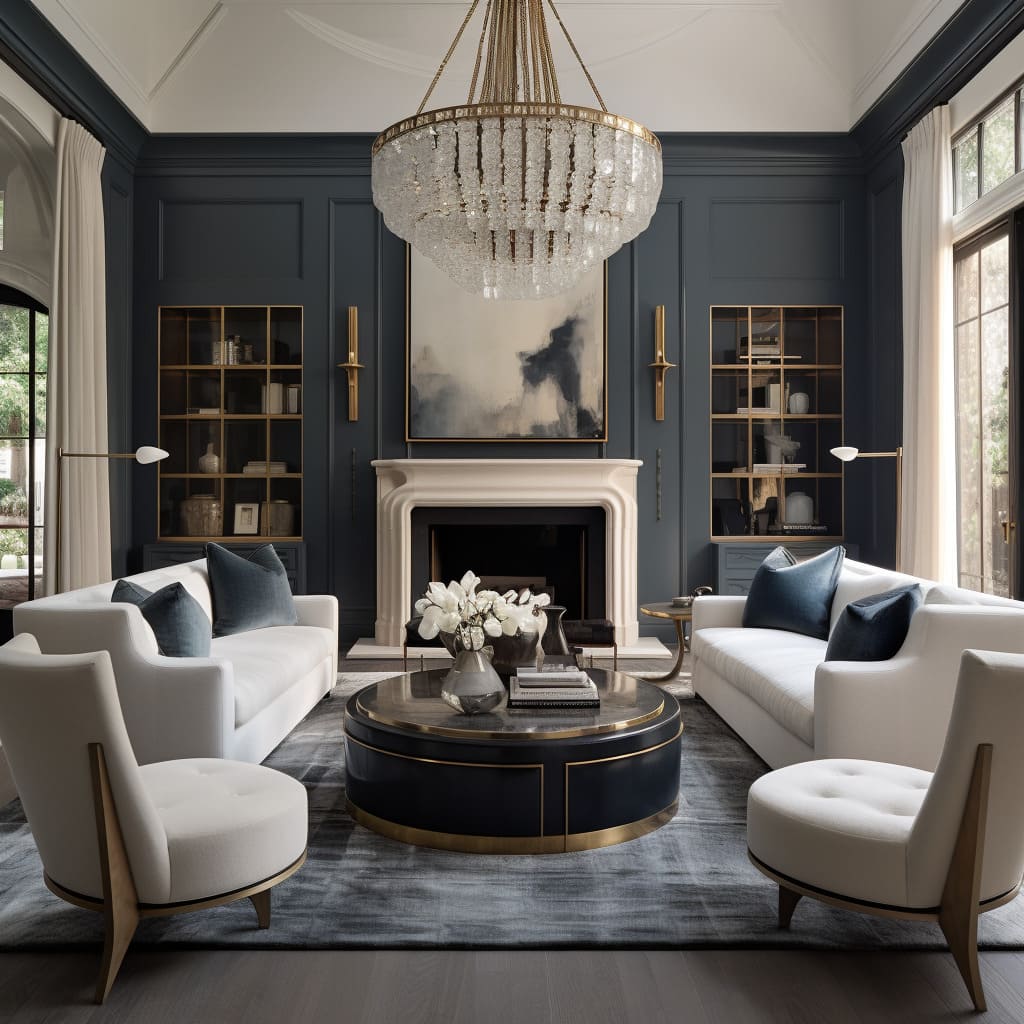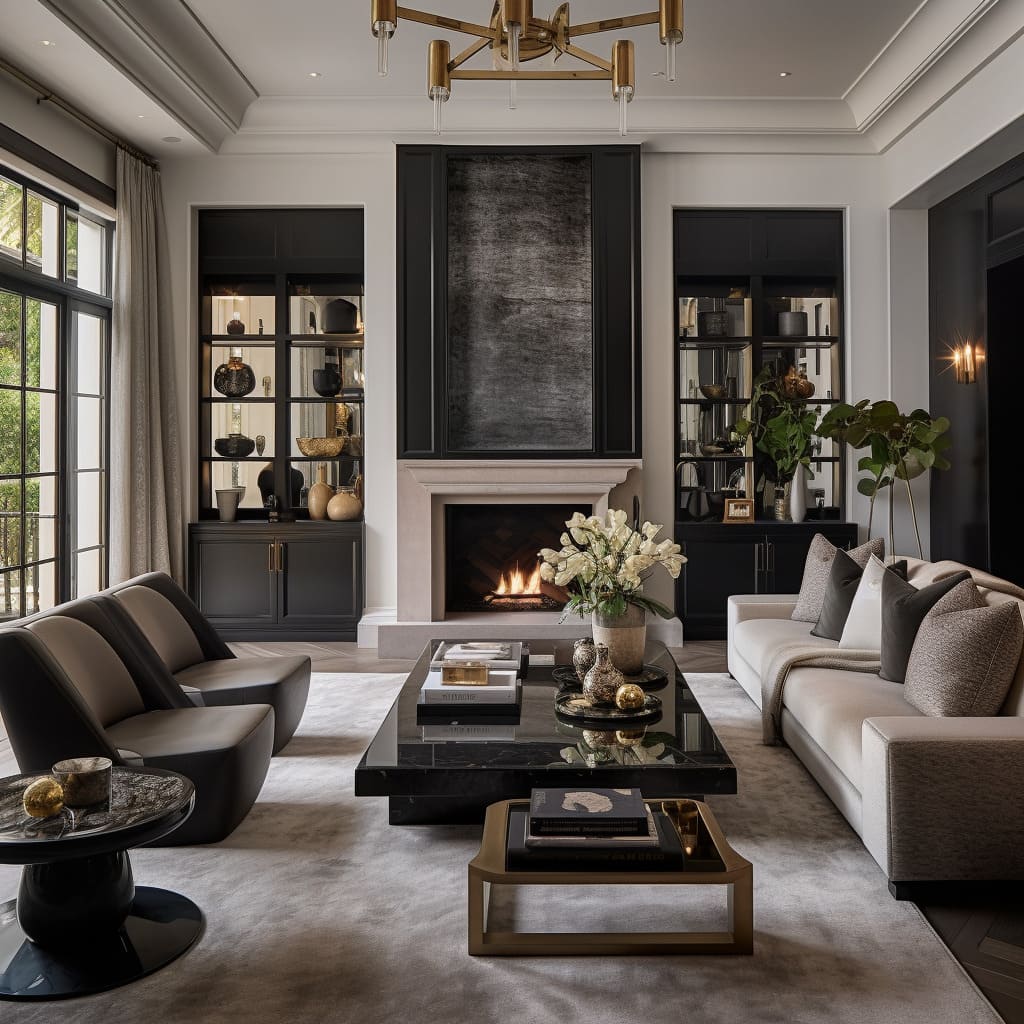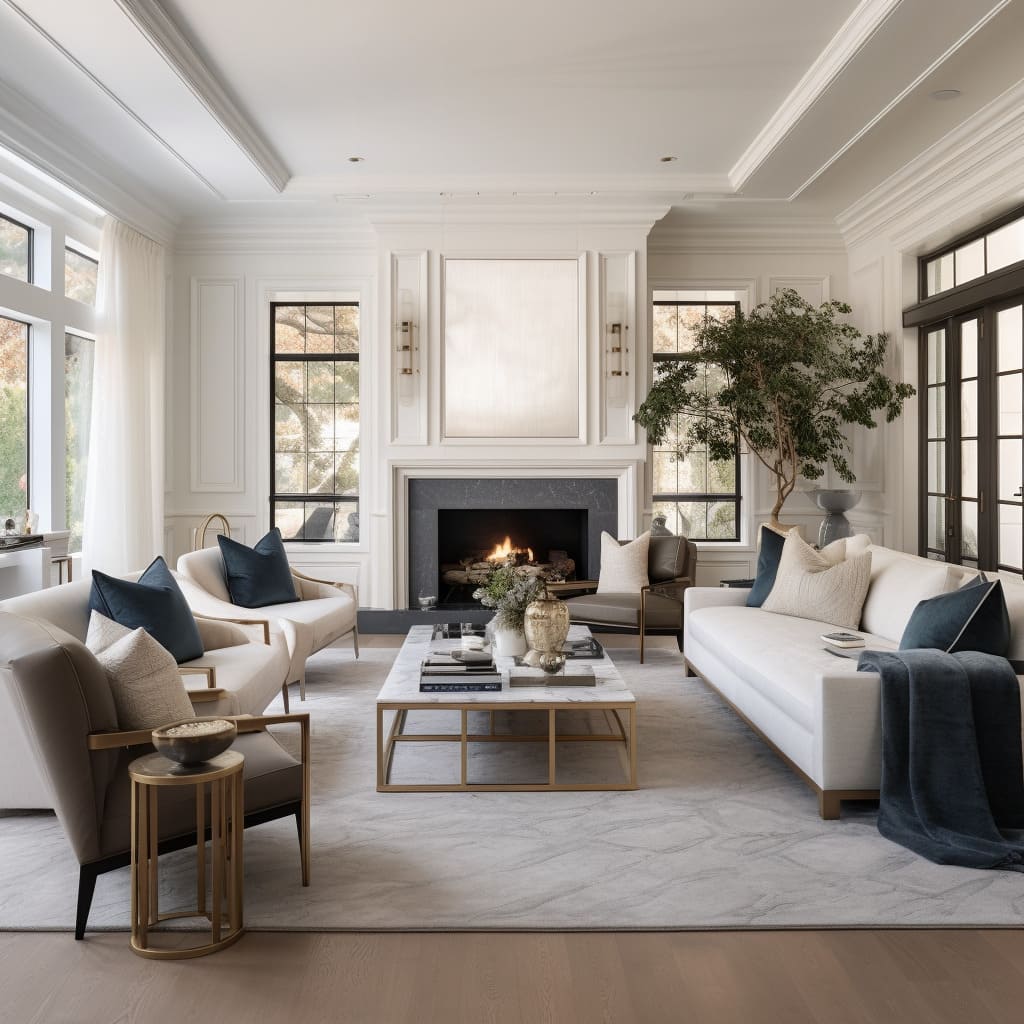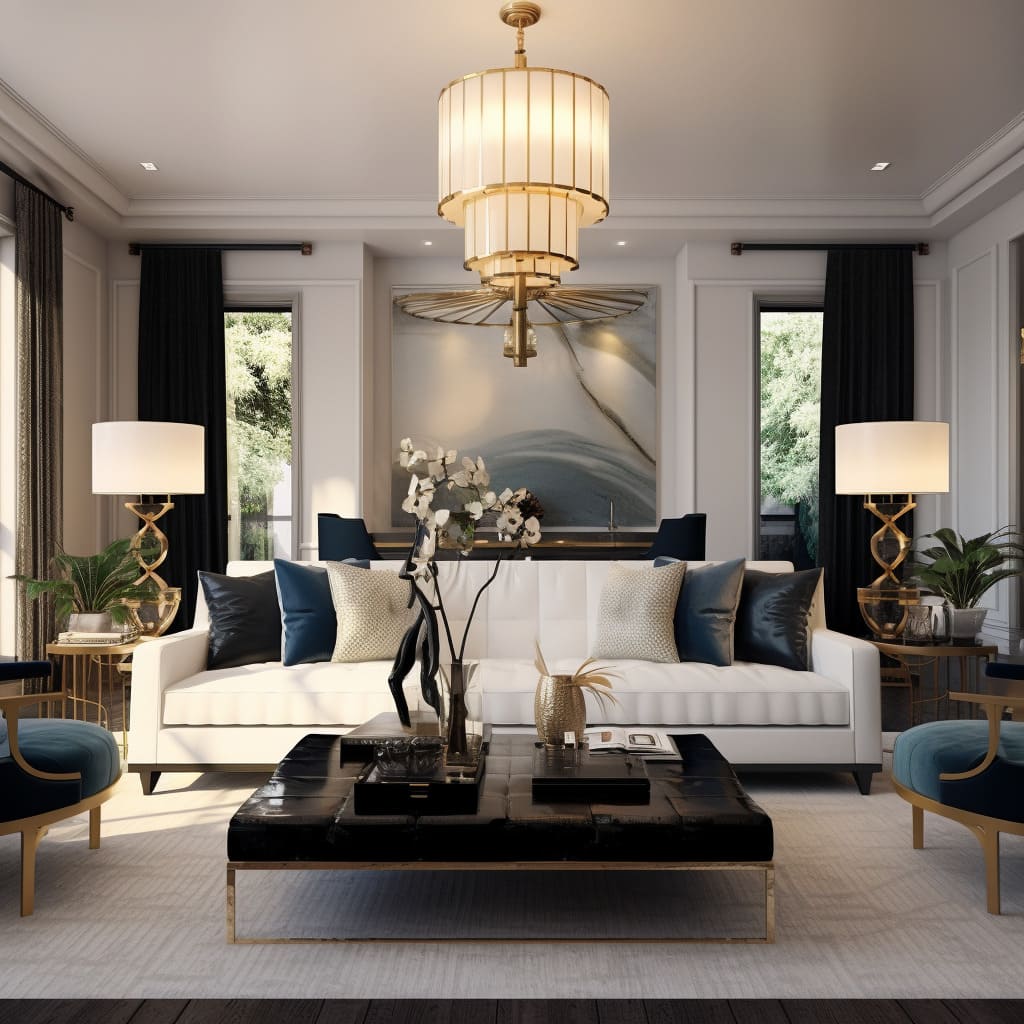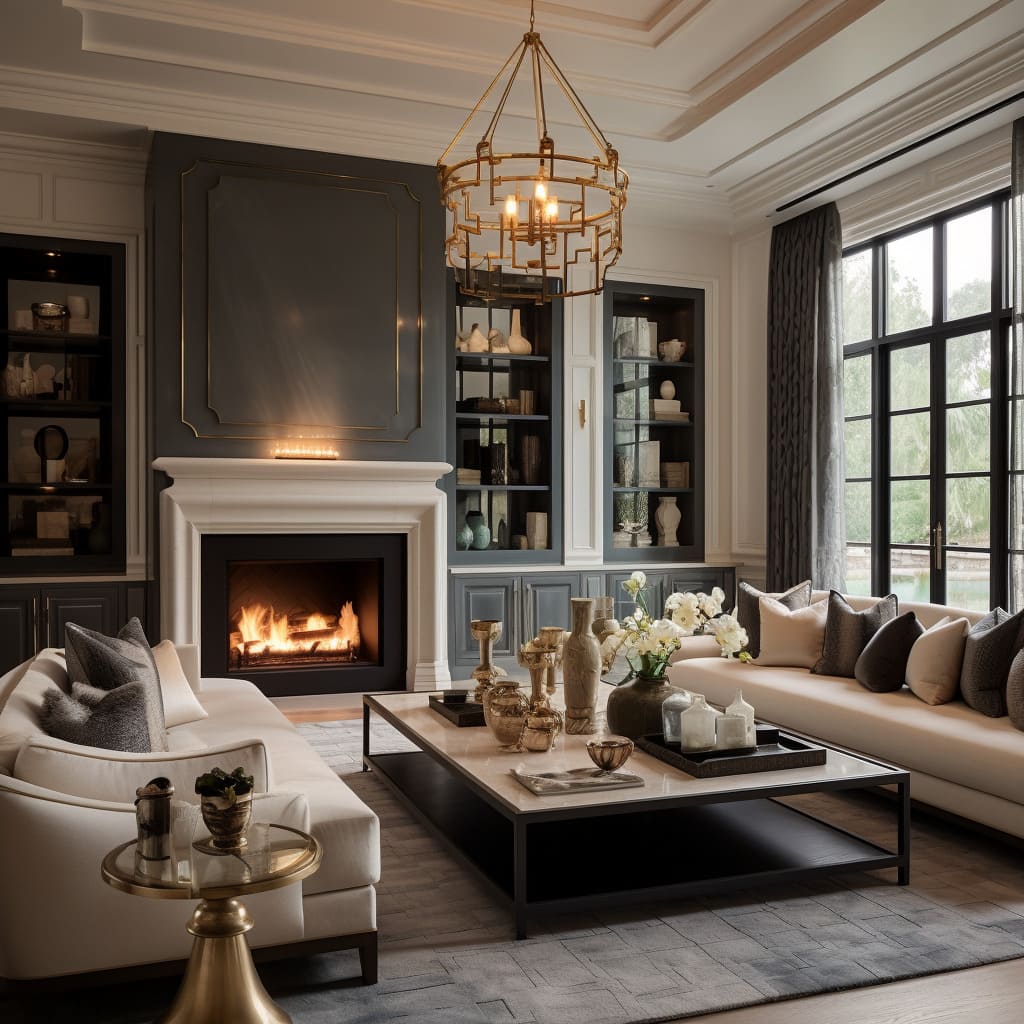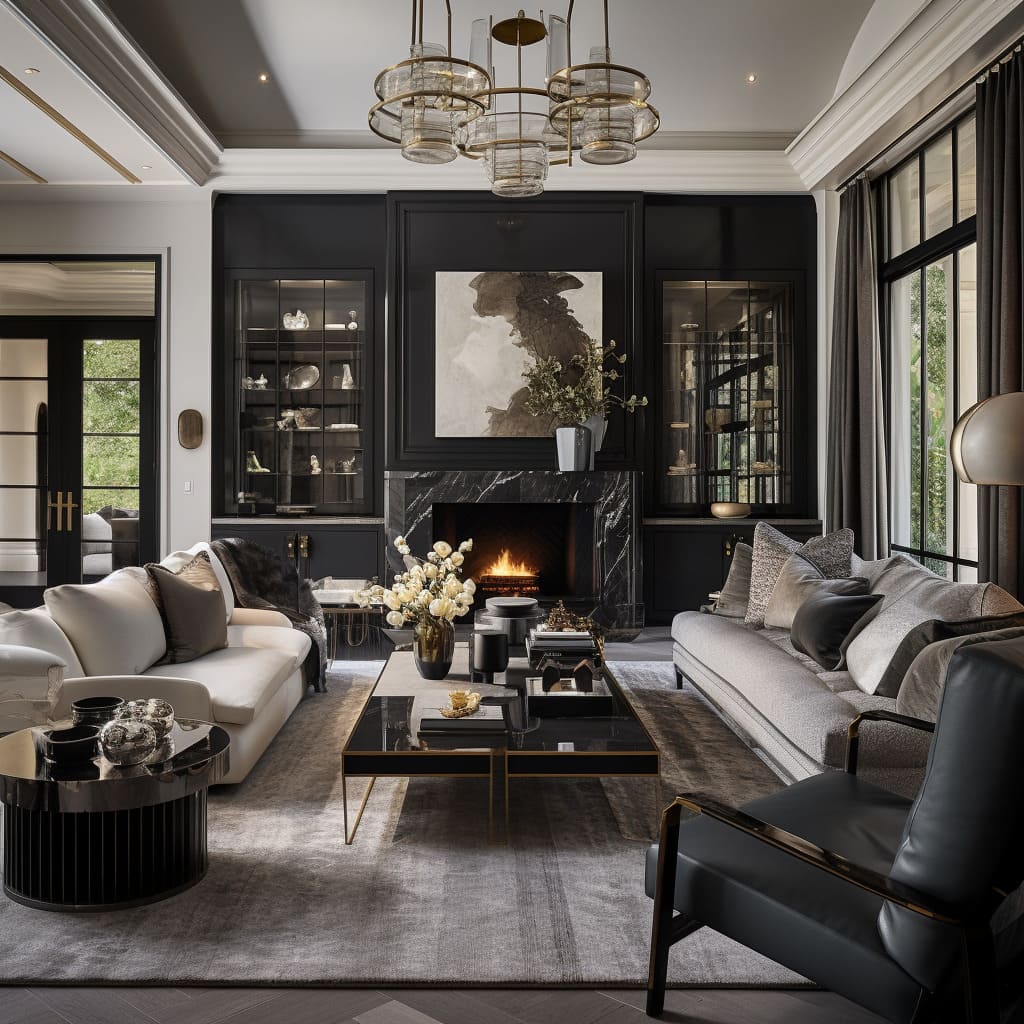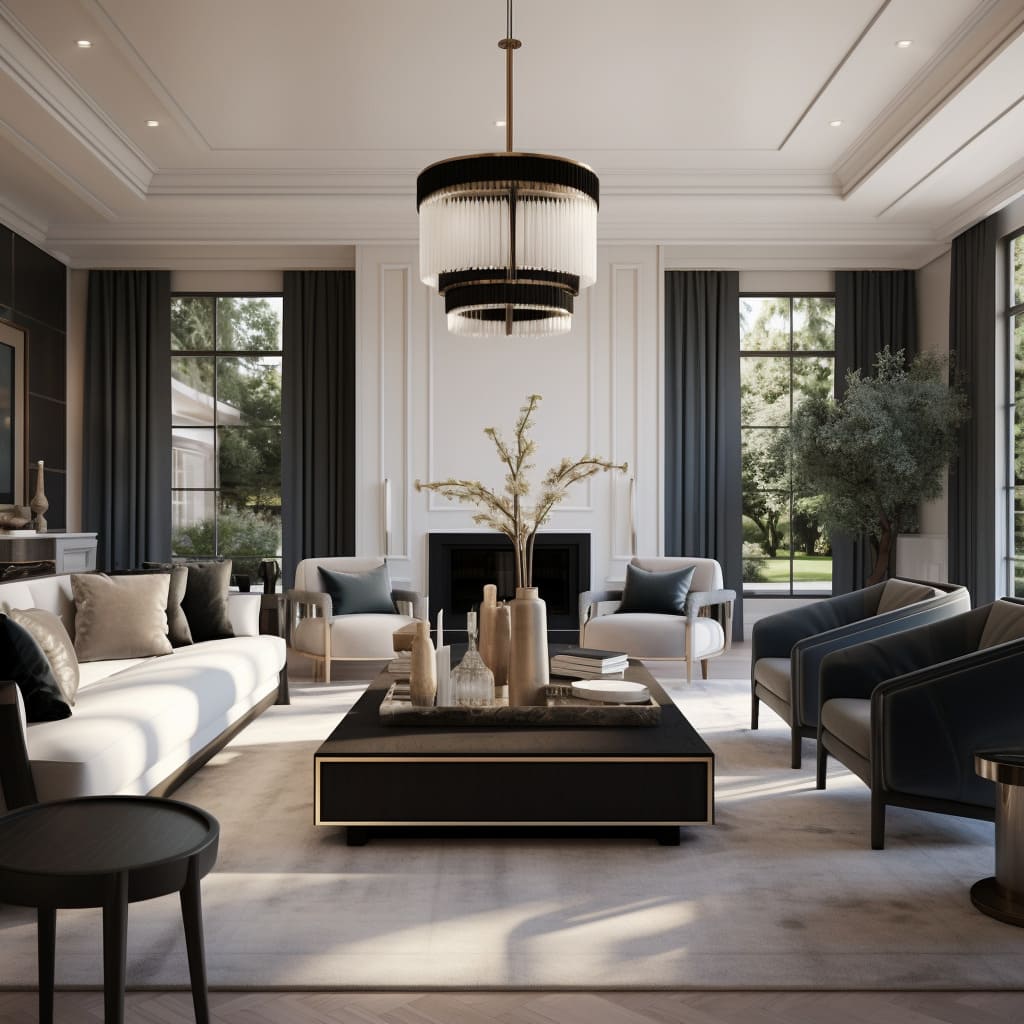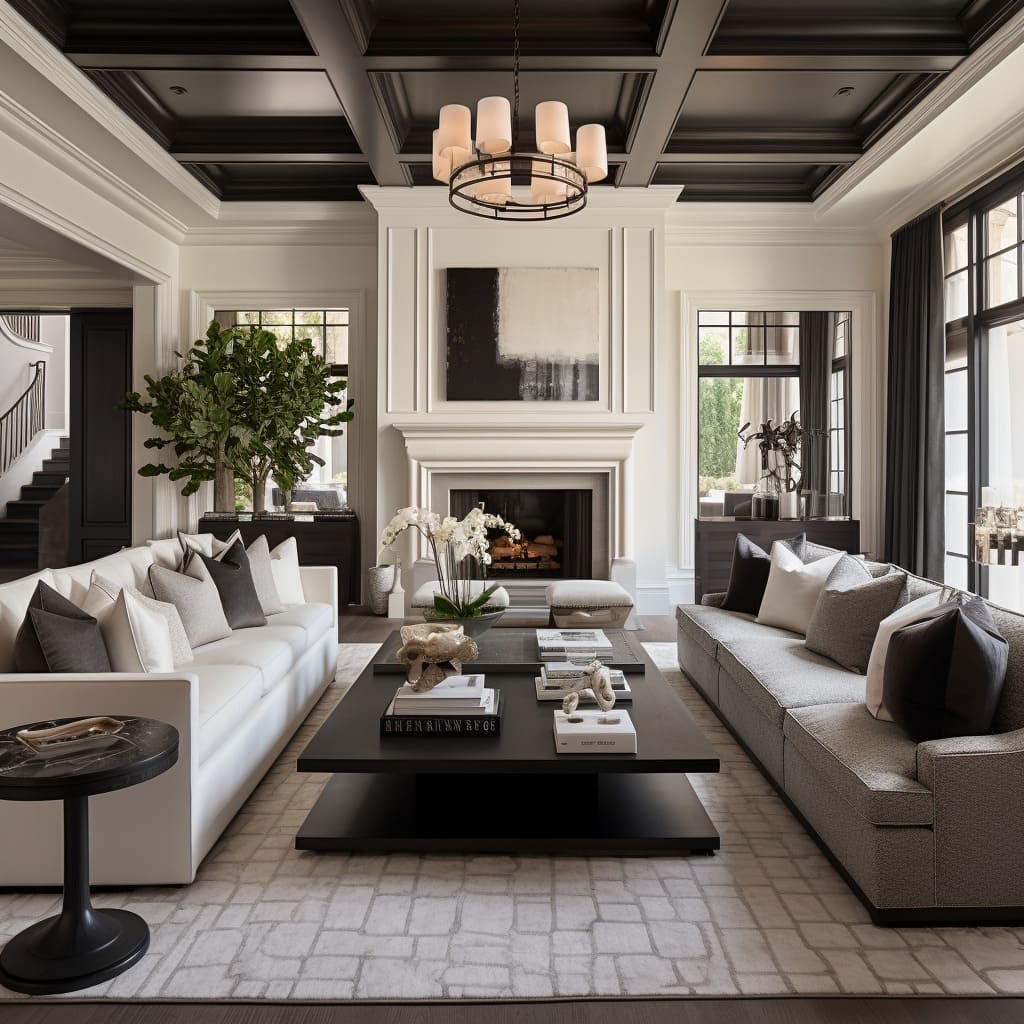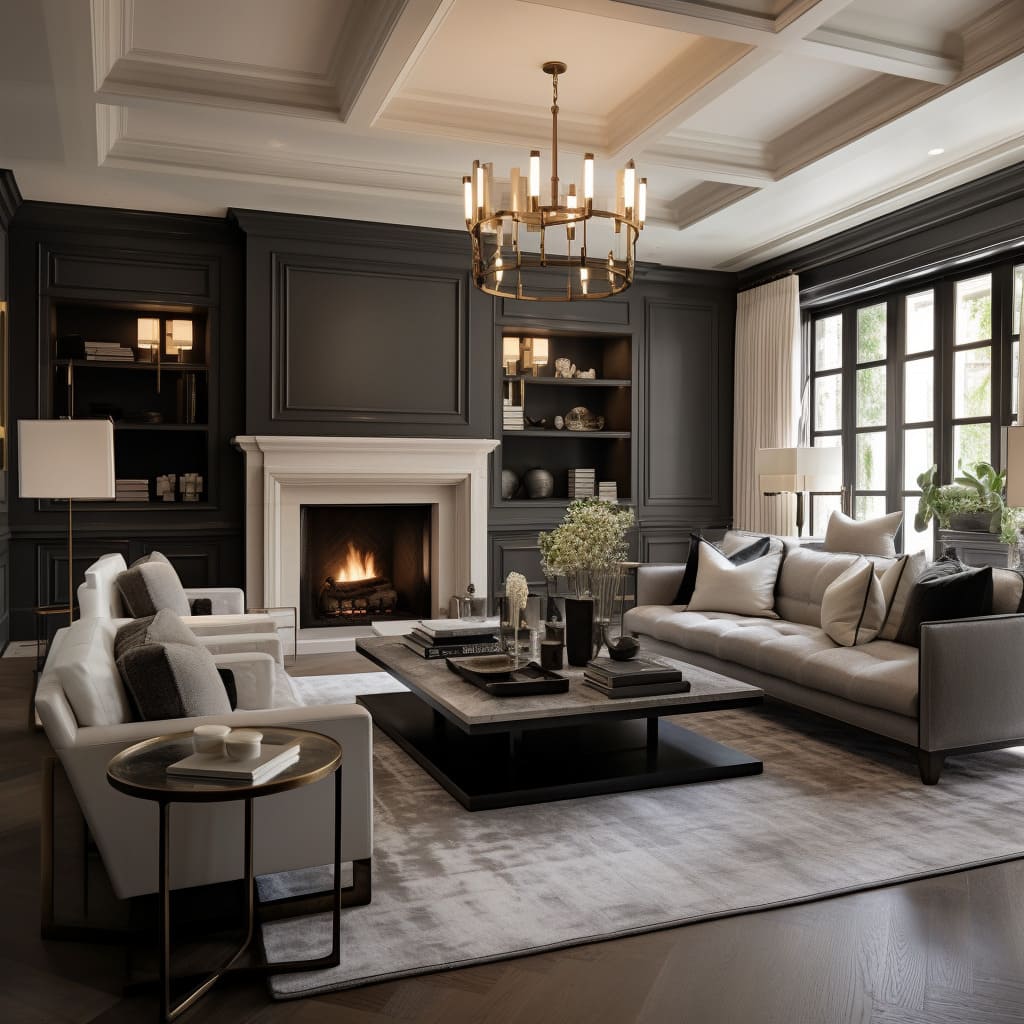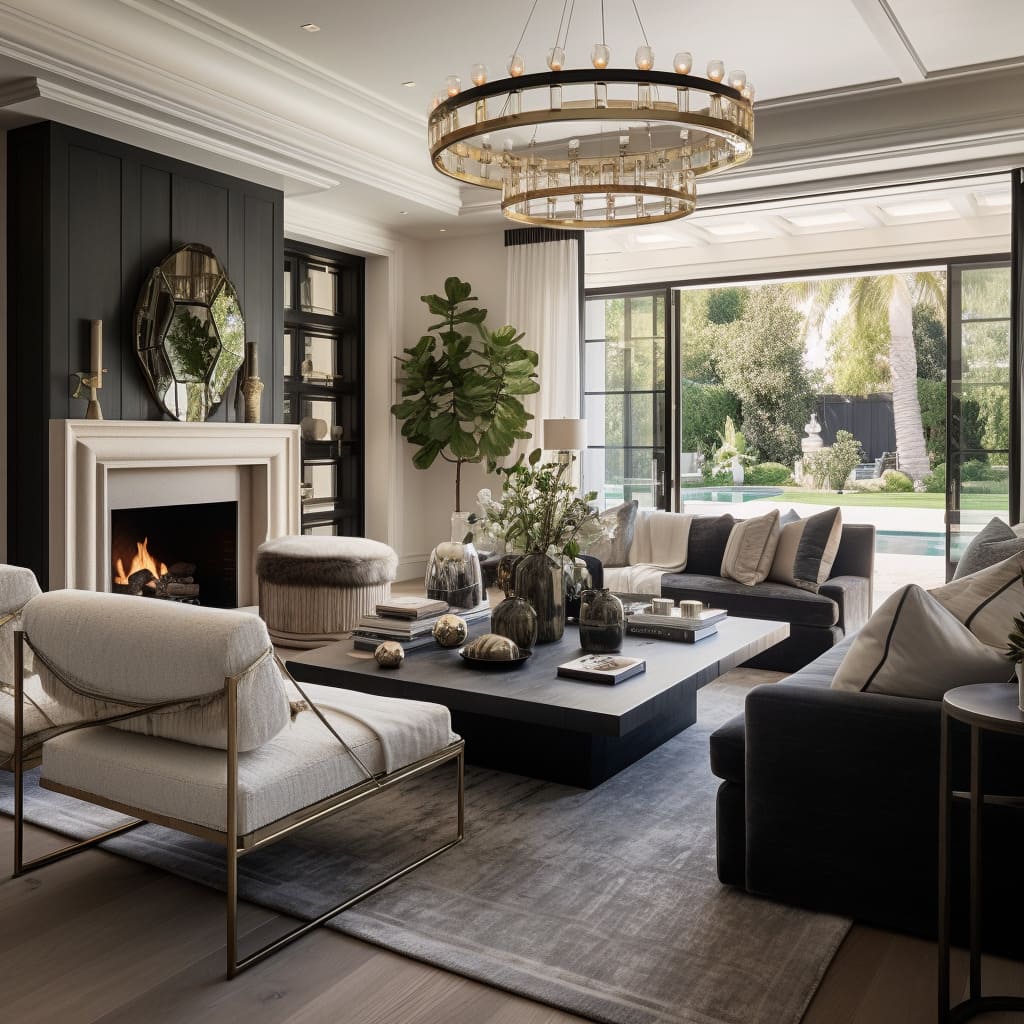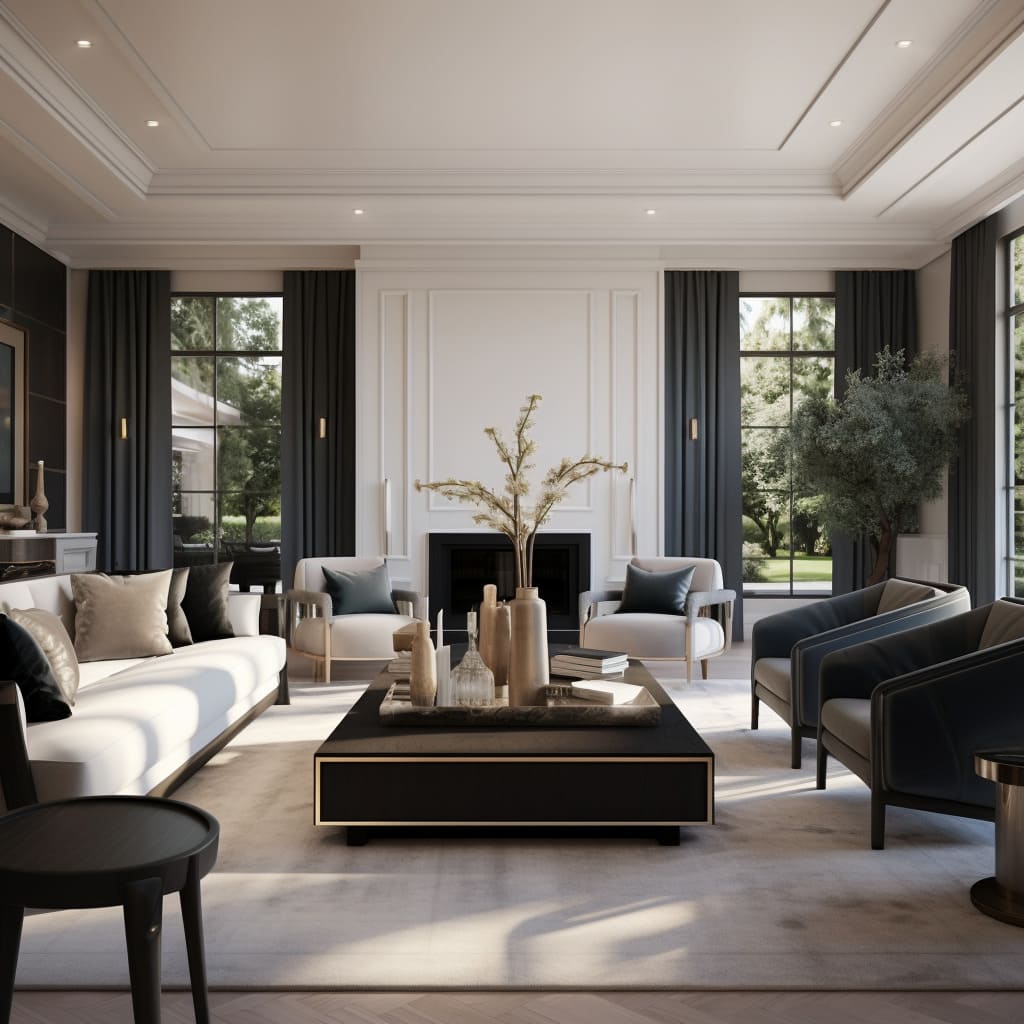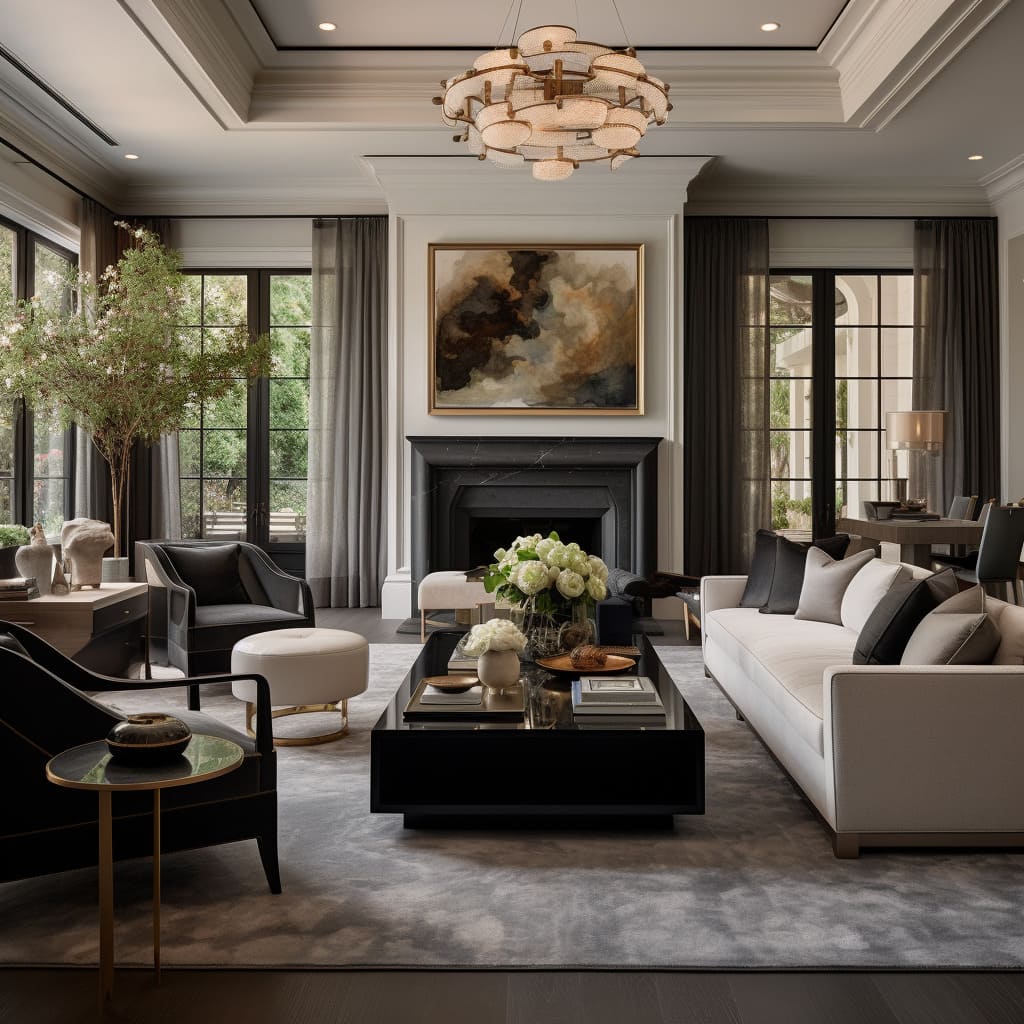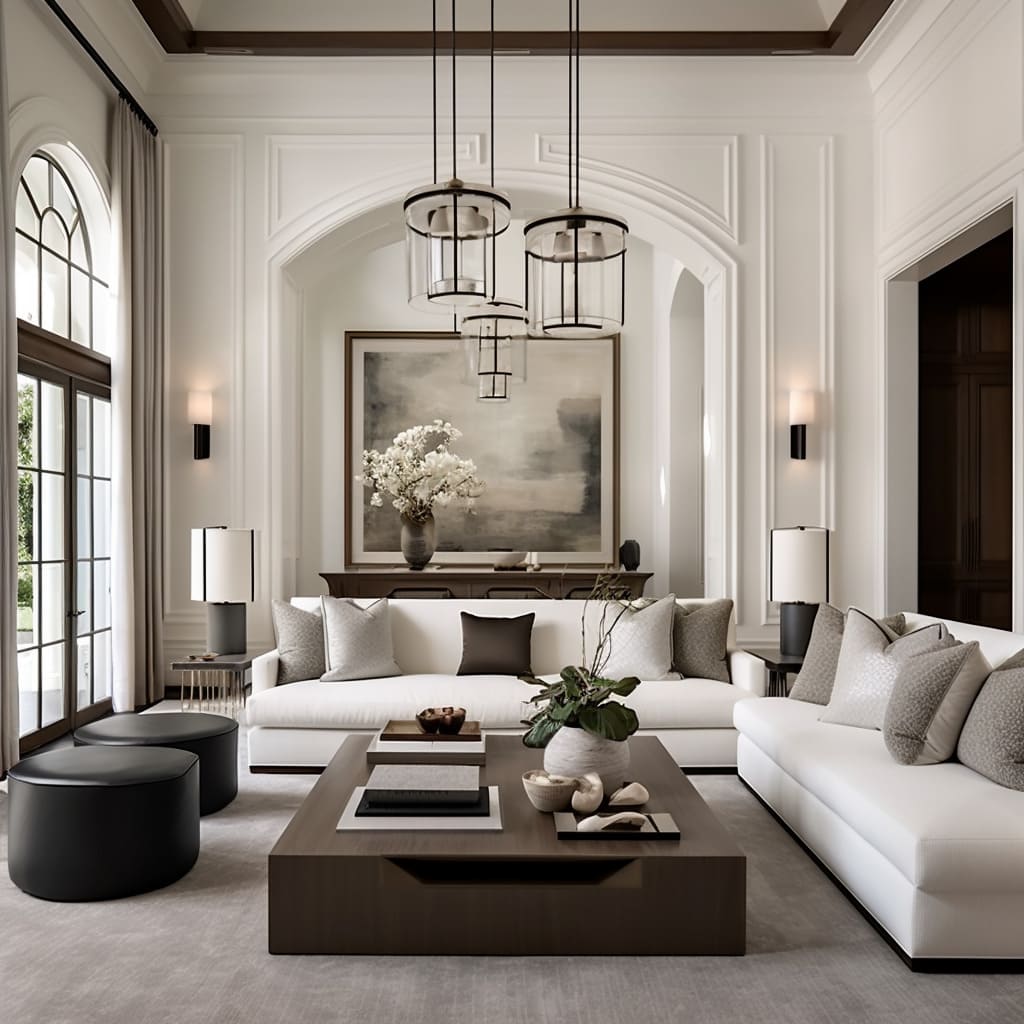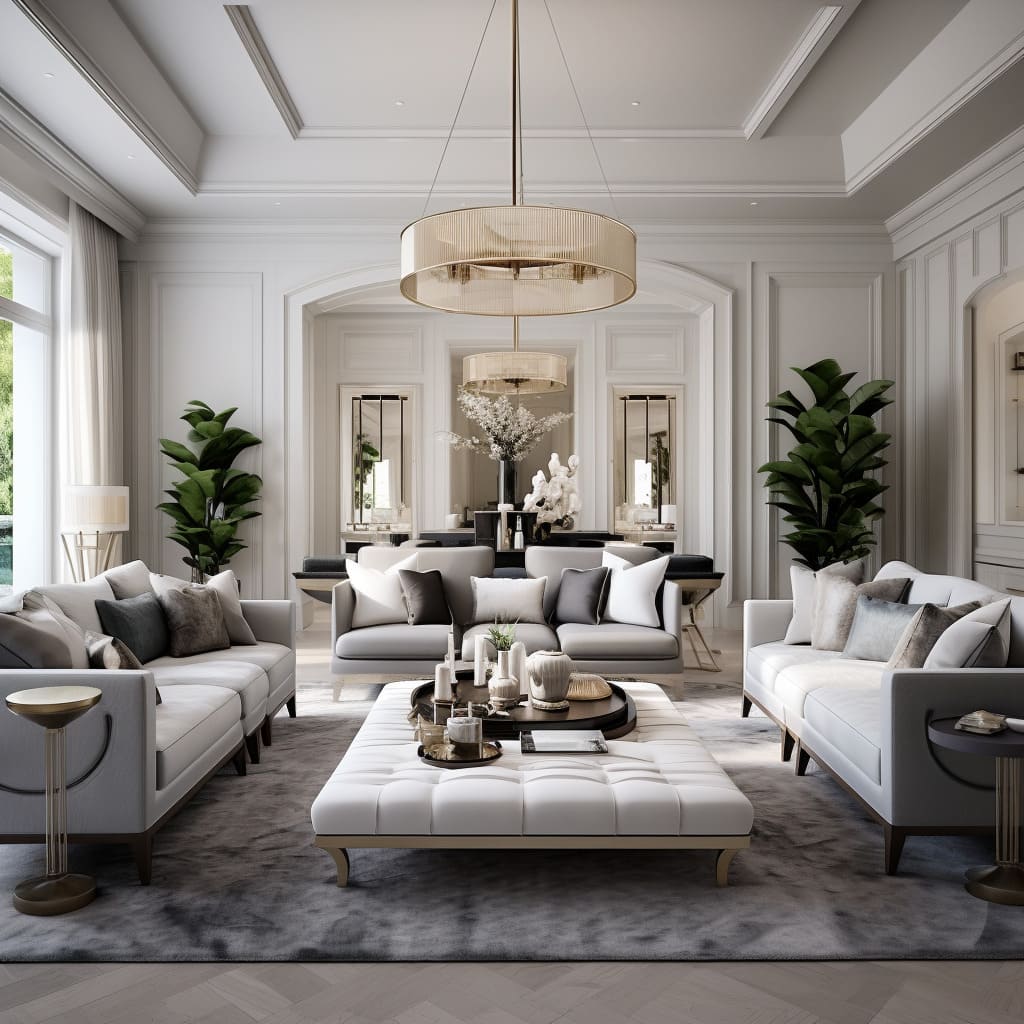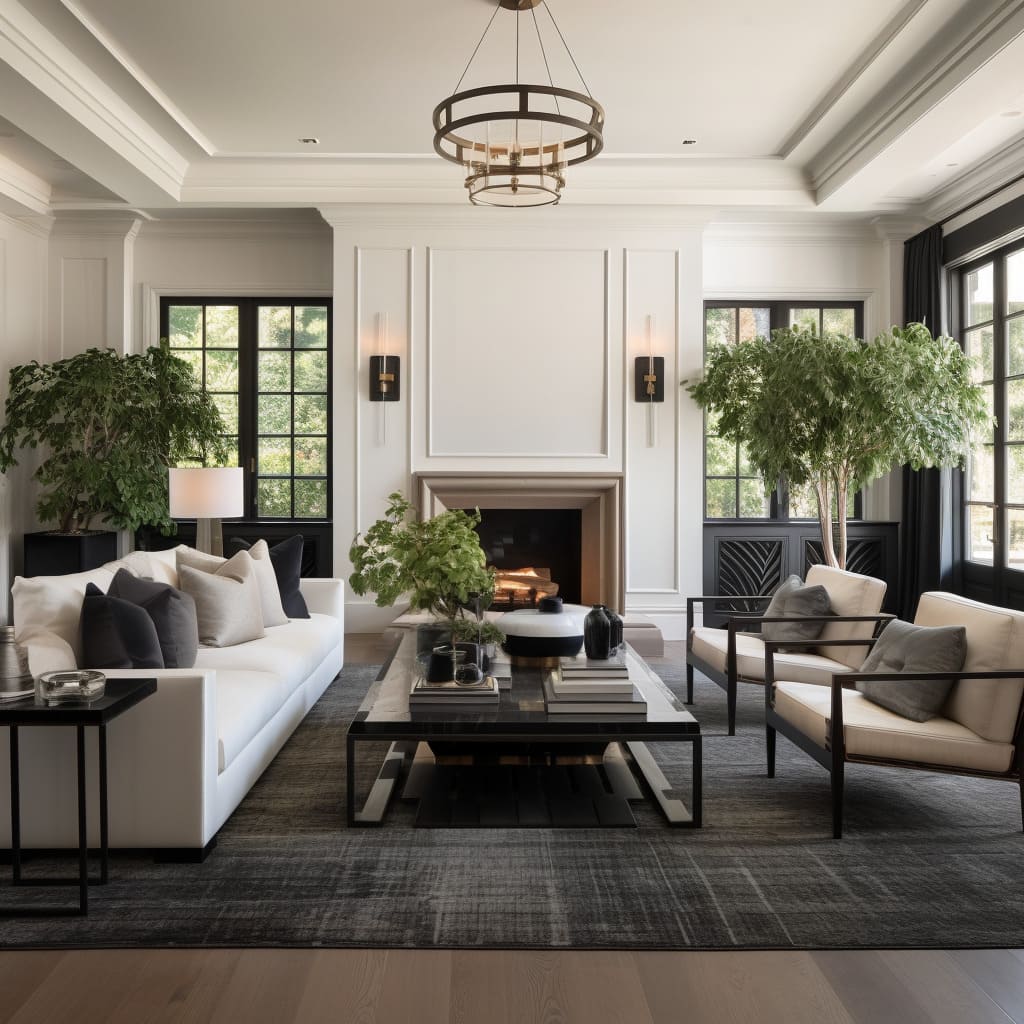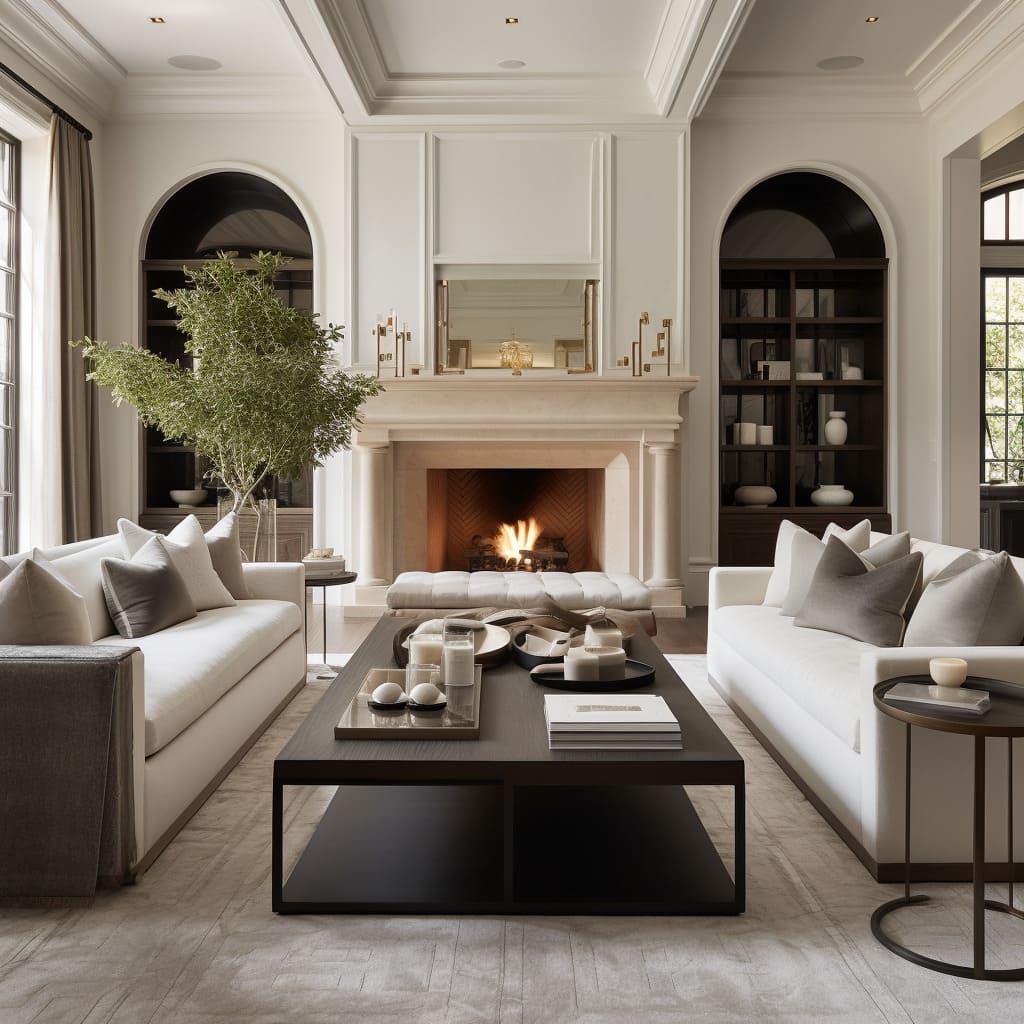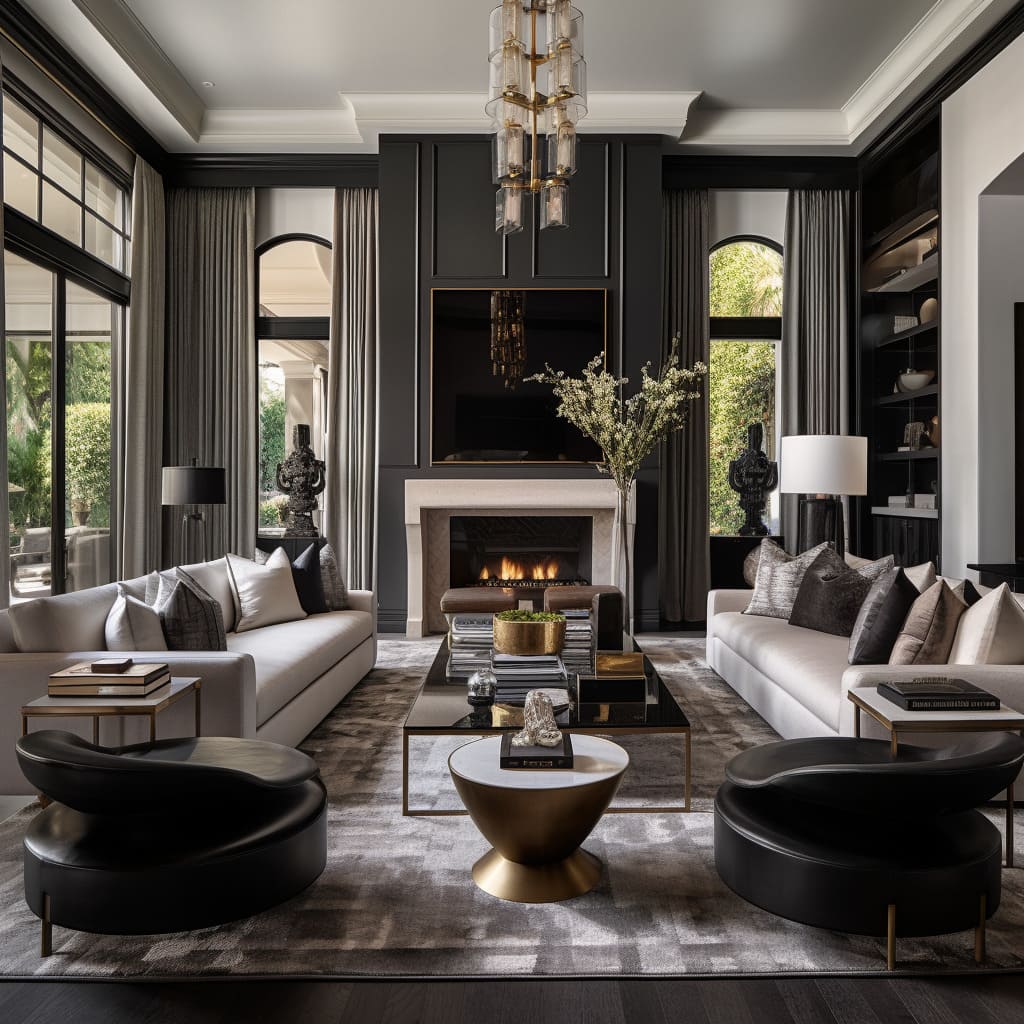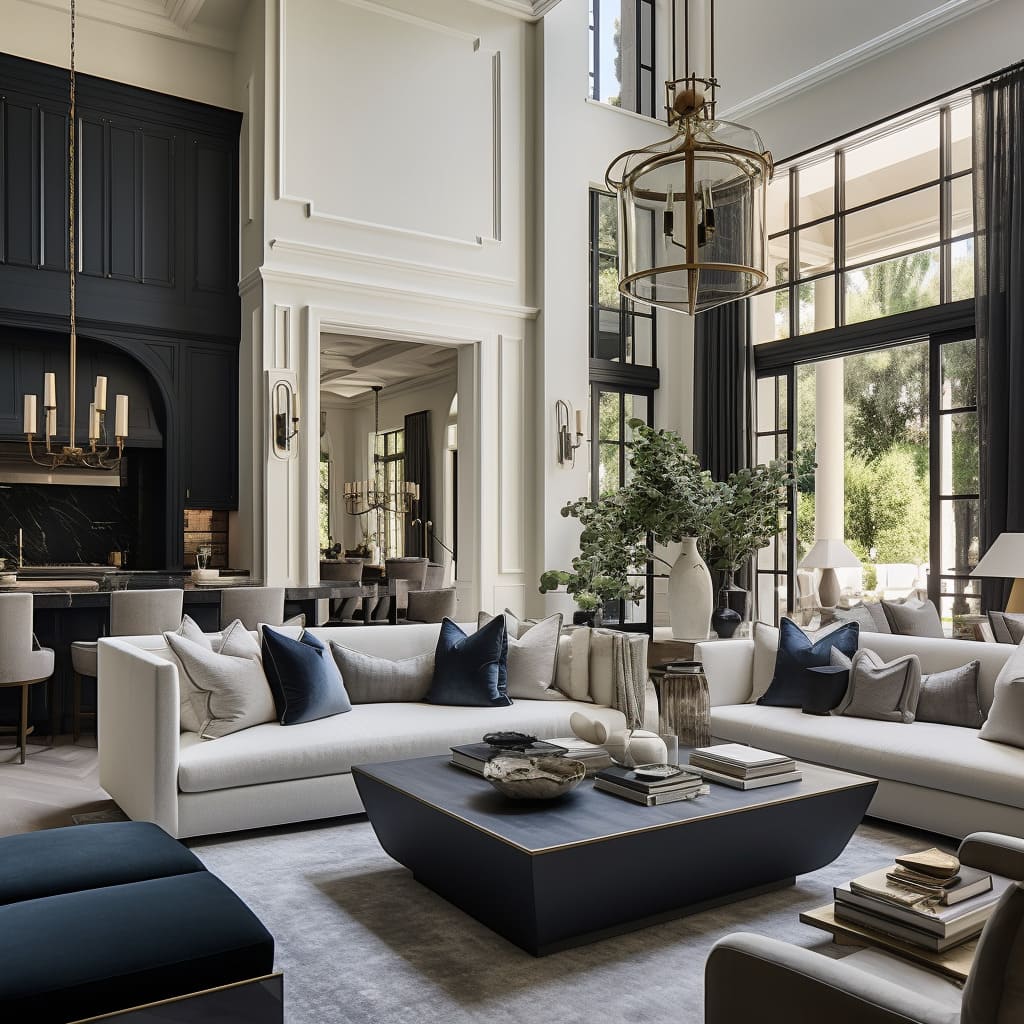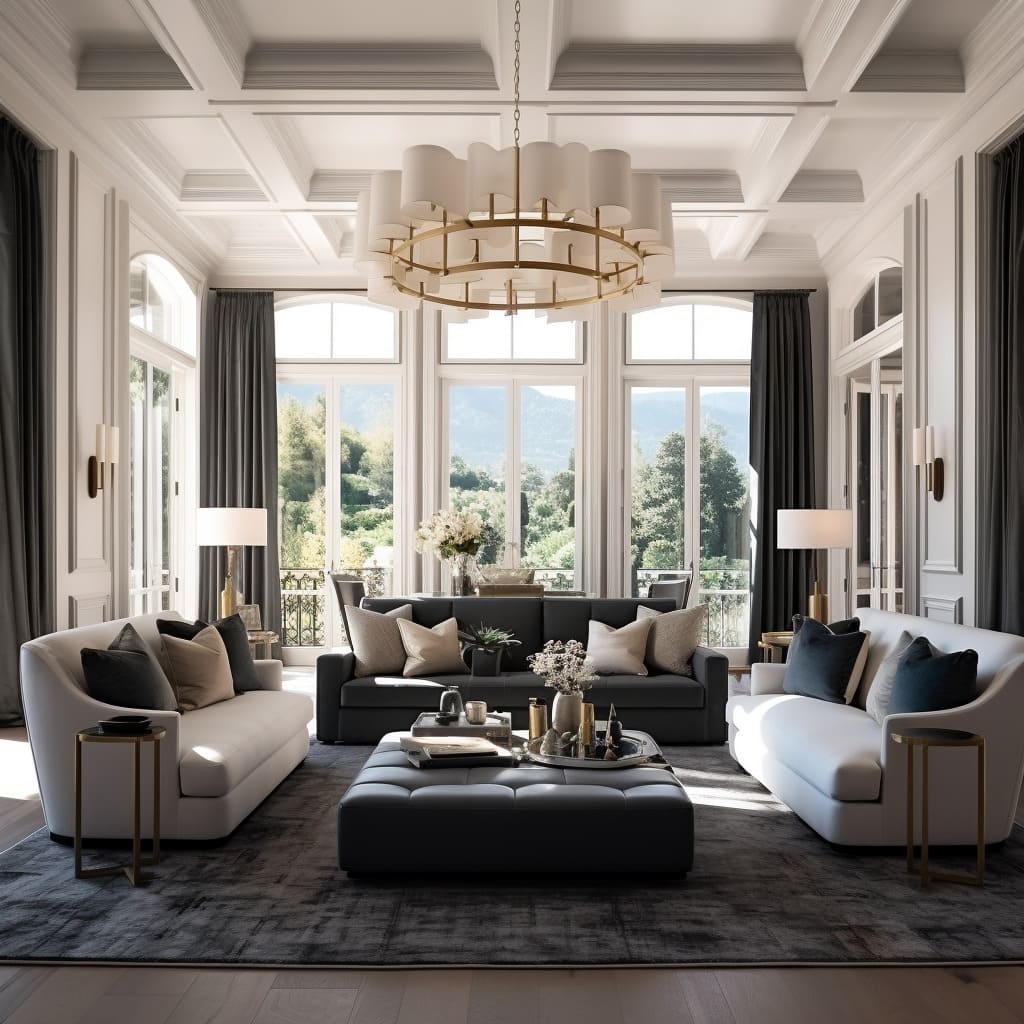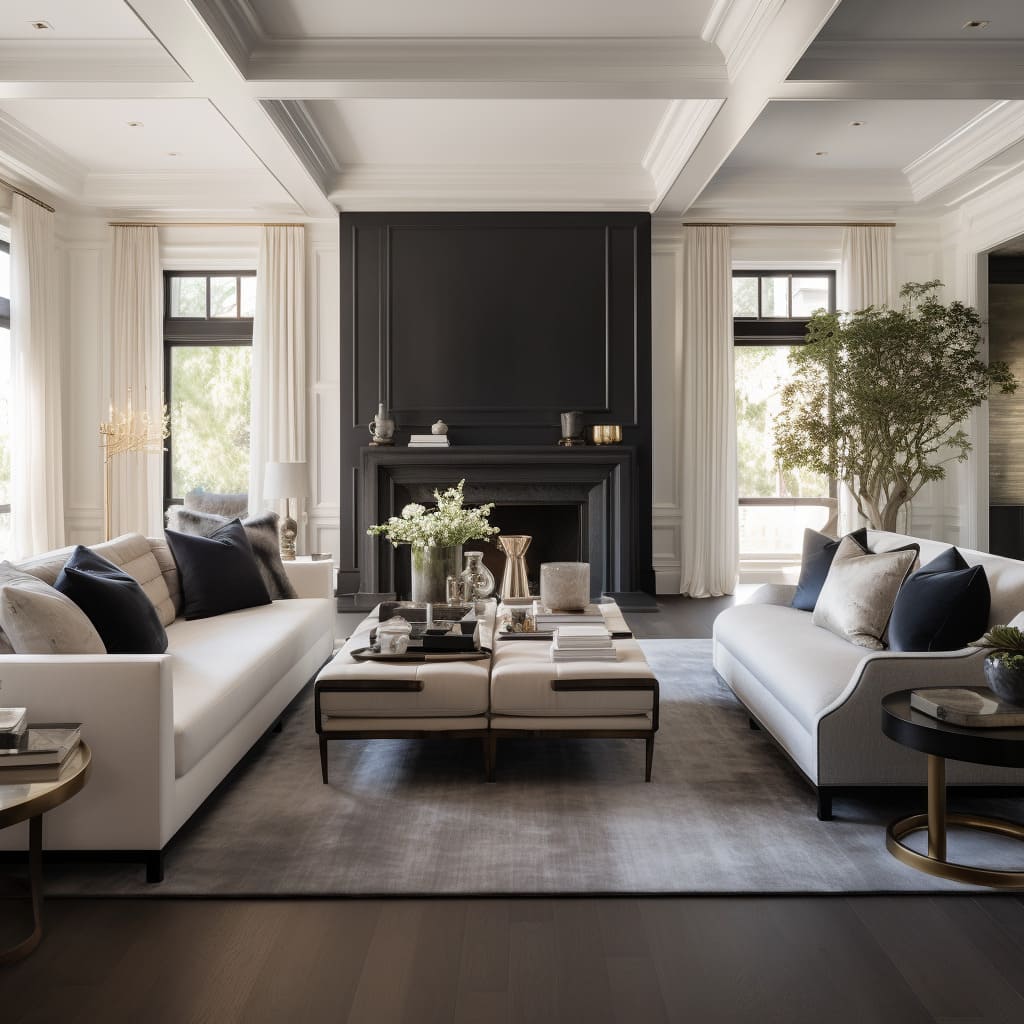Transitional American living room design stands as a testament to the elegance of blending styles, seamlessly merging the warmth of traditional aesthetics with the crisp lines of contemporary decor. This interior design approach creates spaces that are not just stylish but also deeply comfortable and inviting.
The art of this design lies in its ability to balance old and new, creating rooms that feel timeless yet modern, sophisticated yet accessible.
From the choice of furniture to the color schemes and lighting, every aspect of Transitional American living rooms is carefully considered to create a harmonious and cohesive environment. This article delves into the various elements that define this unique style, exploring how each component contributes to the overall look and feel of the space.
Whether it’s the play of light and shadow, the fusion of plush fabrics with sleek finishes, or the incorporation of statement pieces alongside minimalist accents, Transitional American living rooms offer a rich tapestry of design elements that cater to a wide range of tastes and preferences.
The textural elements in Transitional American Interior Design
Transitional American style living rooms are characterized by a harmonious blend of textures that create depth and interest. This design approach focuses on integrating a variety of materials across different elements within the room.
Key features include:
Textured Fireplace: The fireplace often features a textured surround, such as a herringbone pattern, which adds intricate detail against the mantel’s smooth finish. Tactile Table Decor: On coffee tables, an array of objects provides a tactile experience.
This can range from rough decorative wooden beads to smooth ceramic vases and the soft touch of books.
Varied Pillow Fabrics: The sofa pillows showcase diverse materials, including velvety fabrics and woven textiles. This mix enhances both comfort and visual appeal in the seating area.
Contrasting Floor Textures: The area rug under the furniture introduces another texture layer with its plush pile, standing out against the sleek hardwood flooring around it.
This living room exudes a California vibe with its relaxed yet sophisticated design.
These textural elements contribute to a sensory-rich environment, emphasizing the designer’s focus on materiality. This approach goes beyond just color and form, using texture to evoke feelings of warmth and sophistication.
In these living rooms, texture is a key element, adding a tactile dimension that balances and harmonizes the overall design.
Architectural Symmetry
Transitional American living rooms are often designed with a strong emphasis on symmetry and balance, creating a sense of harmony and order. This design principle is evident in several aspects:
Harmonious Furniture Placement: The arrangement and proportion of furniture are carefully considered.
A central feature like a fireplace often acts as the focal point, with seating symmetrically arranged around it.
Balanced Window Spacing: The spacing of windows and other architectural elements is evenly distributed, adding to the room’s balanced feel.
Symmetrical Accents: Accent pieces, such as side tables and matching lamps, are typically arranged in pairs, framing main furniture pieces like sofas and contributing to the room’s orderly appearance.
Consistent Shapes and Lines: The use of similar shapes, like a rectangular coffee table centrally placed, further accentuates the room’s balanced design. Even Visual Weight Distribution: No single element dominates the space.
Built-in cabinetry, for instance, often flanks a central feature like a fireplace, with each side mirroring the other in both form and decor.
This approach to design extends beyond mere physical arrangement. It seeks to create an environment that is intuitively pleasing and serene.
The architectural symmetry and balance in Transitional American living rooms are about crafting a space that feels right and comfortable, offering a sense of well-being and aesthetic enjoyment. This design ethos, though subtle, plays a crucial role in shaping the overall ambiance and sophistication of the space.
Metallic finishes
Metal finishes play a crucial role in enhancing the room’s luxurious feel. These metallic accents are elegantly incorporated throughout the space, providing:
Subtle Sheen and Glamour: Metal accents include slender frames on side tables, lamp bases, coffee table legs, and furniture trim, often in polished brass or gold.
These reflective surfaces elegantly catch the light, adding depth and contributing to the room’s layered lighting.
Textural Contrast: The metallic finishes offer a striking contrast to softer elements like upholstery and rugs, enriching the room’s textural variety.
Sophisticated Aesthetic Connection: These warm metal tones seamlessly connect various furniture pieces and decor, adding a cohesive thread of opulence and bridging the gap between classic architecture and contemporary furnishings.
Balanced Use: The integration of metallics is carefully balanced, ensuring the space remains elegant without being overly ornate.
The furniture selection reflects a modern classic aesthetic.
The thoughtful use of metal finishes exemplifies the designer’s attention to detail, highlighting how even small elements can significantly influence the room’s overall design narrative.
These metallic touches contribute to the sophisticated and luxurious ambiance of Transitional American living rooms, creating a space that is both elegant and inviting.
Light and Dark: Creating Depth
Transitional American living rooms often exhibit a captivating contrast between light and dark tones, enhancing the room’s depth and dimensionality. This design strategy includes:
Bold Dark Features: Prominent elements like built-in cabinetry and fireplace surrounds are often painted in deep, dark hues, such as black.
This dramatic touch acts as a visual anchor, making the room’s architecture stand out.
Standout Objects: Dark tones, especially in cabinetry, accentuate objects placed within or against them, turning these items into focal points.
Airy Light Hues: The majority of the wall space is typically finished in soft, off-white tones, reflecting natural light and adding to the room’s sense of spaciousness.
Heightened Room Scale: The use of light wall colors also highlights the room’s height and complements its grand scale.
This living room showcases the best of California interior design.
This interplay between light and dark creates a dynamic tension, injecting energy and modernity into the space.
It draws attention to different areas, accentuating architectural details and making softer furnishings and decor pop. This contrast provides a layered visual experience, adding complexity and sophistication to the interior design of Transitional American living rooms.
This approach is not just about color but about using light and shadow to create a rich, multi-dimensional space.
Managing Natural Light
Curtains play a pivotal role in controlling natural light and thus, the overall ambiance. Key aspects of these curtains include:
Luxurious Fabric: The curtains are often made of a heavy, luxurious fabric, adding a rich textural element to the room.
Light Color Palette: Usually in light shades like creamy or off-white, they complement the walls and enhance the room’s softness.
Light Diffusion: When drawn, these curtains diffuse the abundant natural light, softening the brightness to create a warm, inviting glow.
Ambiance Modulation: The curtains’ ability to control light is essential for the room’s atmosphere. Closed curtains offer privacy and coziness, while open curtains frame the outdoor view, connecting the inside with the outside and making the space feel larger.
Stylistic Versatility: How the curtains are arranged – whether tied back neatly or left to drape freely – influences the room’s appearance, aligning with either a sophisticated and elegant or a relaxed and casual style.
Transitional design elements offer a perfect blend of classic and contemporary.
Curtains in these living rooms are more than just window treatments; they are integral to the interior design. They serve both functional and aesthetic purposes, significantly contributing to the room’s elegance and the comfort of its inhabitants.
By managing natural light, these curtains help create a space that is both visually appealing and atmospherically comfortable.
Artistic Expression
In Transitional American living rooms, artwork plays a significant role in enhancing the space’s design narrative. These rooms typically feature:
Commanding Artwork: A prominent piece of art, often an abstract landscape or seascape, is usually displayed above the fireplace.
This placement draws immediate attention and signifies the artwork’s importance in the room.
Complementary Color Palette: The artwork’s colors, often blues, whites, and grays, echo the room’s overall color scheme, creating a cohesive look.
Focal Point Creation: Its large scale establishes the artwork as a focal point within the room, particularly when set within a traditional mantel frame.
Dynamic Brushwork: The textured and dynamic brushwork in the painting adds a contrasting element to the room’s orderly and calm aesthetic, introducing complexity and depth.
Sophisticated Atmosphere: This contrast not only invites contemplation but also contributes to the room’s sophisticated ambiance.
Harmonious Integration: The artwork complements rather than overpowers the room’s design, maintaining a balance between art and interior decoration.
Plush sofas make this living room perfect for relaxation.
Art in these living rooms is not just a decorative addition; it’s an integral part of the interior design. It serves as a visual anchor, tying together various elements of the room and showcasing the designer’s meticulous attention to detail.
This careful integration of art into the living space creates an engaging, cohesive, and sophisticated environment.
Table Lamps
Table lamps in Transitional American living rooms are not just functional; they are key elements of design, offering both illumination and style. These lamps are characterized by:
Substantial Design: The lamps typically have large, elegant bases, contributing significantly to the room’s decor.
Soft Lighting: Equipped with shades that emit a soft, diffused light, they create a warm and ambient atmosphere.
Luxurious Touches: Some lamps feature bases with reflective golden finishes and artistic motifs, adding luxury and flair.
Functional Placement: Positioned strategically, like on side tables next to seating areas, these lamps balance functionality with decorative appeal.
Traditional Elegance: Other lamps may have more traditional, neutral-colored bases with classic vase-like forms, enhancing the room’s transitional aesthetic.
Cohesive Look: The shades, often simple drum types, ensure that the light cast is ambient while contributing to the room’s cohesive appearance.
Even Light Distribution: Their strategic placement around the room ensures even light distribution, creating a welcoming and comfortable atmosphere.
The interior design of this living room showcases a timeless and inviting space. In these living rooms, table lamps serve as sculptural elements that enhance the overall design.
They are carefully selected for both their stylish forms and the quality of light they provide, playing a vital role in the ambiance of the space. This attention to detail in both form and function is a hallmark of thoughtful interior design in Transitional American living rooms.
Ceiling Fans
In Transitional American living rooms, ceiling fans play a dual role, blending functionality with style. These fans are often characterized by:
Sleek Contemporary Design: The fans typically feature a large, dark-toned fixture with a modern, sleek design.
Effective Air Circulation: Their expansive blades are efficient at circulating air, enhancing the room’s comfort.
Contrasting Color Scheme: The darker color of the fan creates a striking contrast with the lighter ceiling tones, making it a prominent design element.
Integrated Lighting: Many of these fans include a lighting fixture at their center, contributing to the room’s layered lighting approach alongside table lamps and natural light from windows.
Dual Functionality: The fan’s ability to provide both cooling and lighting is a key aspect of modern interior design, offering both utility and aesthetic appeal.
Complementary Styling: Its modern design aligns well with the transitional style of the room, merging traditional and contemporary elements.
Comfort Consideration: The presence of the ceiling fan is a testament to the importance of comfort in the room’s design, ensuring the space is not only visually appealing but also physically welcoming.
The house boasts a spacious living room with a timeless interior. Ceiling fans in these living rooms are more than just practical appliances; they are integral to the overall design, balancing the need for comfort with the desire for a cohesive and elegant aesthetic.
Their functionality and style make them a crucial element in creating a comfortable, inviting, and stylish living environment.
Depth and Drama
Transitional American living rooms often feature sophisticated wall treatments that add depth and character. These treatments typically include:
Elegant Paneling Design: The walls are adorned with a combination of recessed panels and raised moldings.
This design plays with shadow and light, enhancing the room’s architectural details.
Contrasting Colors: The paneling is often painted in a dark hue, providing a bold contrast to the lighter tones of the surrounding walls and ceiling.
This contrast highlights the room’s height and grandeur.
Dramatic Backdrop: The dark panels create a striking background for lighter-toned furniture and shelving, also framing artwork and the fireplace for a gallery-like effect.
Focus and Sophistication: This contrast between the wall treatment and other room elements adds sophistication and serves as a focal point, anchoring the space.
Cozy Atmosphere: The dark color of the paneling enhances the room’s coziness, offering a sense of intimacy within an open-plan layout.
Texture and Color Highlighting: The paneling’s dark tone also emphasizes the textures and colors of objects against it, from upholstered furniture to decorative accents.
This living room captures the essence of California style. This wall treatment reflects a meticulous attention to detail in the room’s design, turning the backdrop into a key component of the living room’s luxurious and cohesive aesthetic.
The combination of color, texture, and architectural elements in the paneling contributes significantly to the overall feel and style of the space.
Flooring and Rug Synergy
The flooring and rug combination significantly contributes to the room’s elegant ambiance. Key aspects of this design choice include:
Rich Dark Hardwood: The floor is often made of luxurious dark hardwood, providing a solid and sophisticated base.
Herringbone Pattern: The wood planks are typically laid in a herringbone pattern, adding classic design and visual interest. This pattern also guides the eye towards the room’s center, enhancing the space’s architectural geometry.
Plush Area Rug: A large area rug, featuring a subtle abstract pattern in muted greys and beiges, complements the room’s neutral color scheme.
The rug’s plush texture contrasts with the sleek wood flooring.
Space Definition and Comfort: The rug anchors the seating area, defines the space, and adds a layer of warmth, making it inviting and comfortable underfoot.
Cohesive Interior Design: The combination of the intricate wood flooring and the elegant rug highlights the designer’s attention to detail.
It emphasizes the importance of texture and pattern in creating a cohesive and luxurious interior.
Visual and Tactile Contrast: The choice of flooring is pivotal in setting the room’s tone, providing a visual and tactile contrast that enriches the overall design.
The classic meets contemporary charm of this living room is inviting. This thoughtful integration of flooring and rug in these living rooms lays the foundation for an elegant and sophisticated atmosphere.
It’s not just about the individual elements, but how they work together to create a harmonious and luxurious living space.
Furniture Placement
Transitional American living rooms demonstrate a refined and contemporary approach to furniture selection and arrangement, focusing on:
Inviting Seating Arrangement: The sofas are arranged to create a welcoming atmosphere for socializing and relaxation. They are substantial, plush, and upholstered in light, neutral fabric, contributing to the room’s airy ambiance.
Complementary Throw Pillows: Modern lines of the sofas are softened with throw pillows in various colors and textures, adding depth and interest.
Elegant Coffee Table: The central element is a sizable, rectangular coffee table with a sleek black surface and brass frame, offering both function and modern elegance.
Functional Decor: The coffee table serves as a space for decorative objects, books, and flowers, adding personal touches to the room.
Accent Tables for Balance: Slender accent tables flank the sofas, their dark tones providing visual anchors and extra surface space without overcrowding the space.
Ambient Lighting: These tables often hold lamps that contribute to the room’s warm and welcoming ambiance.
Flow and Symmetry: The furniture is strategically placed to allow easy movement and interaction, maintaining a sense of order and symmetry.
This furniture arrangement in Transitional American living rooms is not merely about placing items; it’s a deliberate strategy to ensure each piece serves a purpose while contributing to the room’s harmonious and sophisticated aesthetic. The layout exemplifies a careful balance between functionality, comfort, and visual appeal, creating a space that is both stylish and inviting.
Blending Tradition and Modernity in Living Room Design
Transitional designs exemplify opulence, combining classic design elements with contemporary aesthetics. Features of these rooms include:
High Ceilings with Traditional Elegance: Spacious rooms with high ceilings are often adorned with intricate crown molding, adding traditional sophistication.
Breathtaking Views: Large, floor-to-ceiling windows are a central feature, offering stunning views of natural landscapes and allowing natural light to accentuate the room’s grandeur.
Neutral Color Palette: Shades of white, cream, and gray dominate, with dark-toned sofas and accent pillows creating a balanced and sophisticated look.
Furniture Mix: A blend of modern and classic furniture includes plush, oversized sofas and a large, tufted ottoman, which doubles as a coffee table and is decorated with items like books and candles.
Contemporary Lighting: A brass chandelier with a tiered design provides warm lighting, complemented by elegant floor lamps with a minimalist design.
White Paneling and Hardwood Flooring: Tall white paneling adds depth, while hardwood flooring is covered with a large, dark gray area rug, enhancing texture and comfort.
Minimalistic Decor: The decor is minimal yet thoughtful, with selected pieces enhancing the room’s luxurious feel without overwhelming the space.
Classic architecture meets contemporary accents in this home.
These living rooms strike a perfect balance between refined comfort and timeless style, showcasing a blend of traditional charm and modern sophistication. The overall effect is an inviting, luxurious space that appeals to both contemporary and classic tastes.
The essence of Transitional American living room design lies in its masterful blend of traditional charm and modern elegance. This design approach creates spaces that are both luxurious and inviting, characterized by high ceilings, spacious layouts, and an infusion of natural light through large windows.
The sophisticated use of neutral color palettes, combined with strategic pops of darker tones in furniture and accents, establishes a refined yet welcoming ambiance. The furnishings, a curated mix of modern and classic styles, ensure comfort without compromising on aesthetic appeal.
Key elements like plush sofas, elegant ottomans, and minimalist lighting fixtures contribute to a cohesive look that is both timeless and contemporary. The thoughtful inclusion of intricate details, such as crown molding, paneling, and carefully selected decor, adds layers of depth and character.
Such designs are functional, comfortable, and adaptable, meeting the needs of modern living while retaining a sense of classic elegance. This design style celebrates the harmony of different eras, bringing together the best of both worlds to create spaces that are not only beautiful but also resonate with a sense of warmth and sophistication.



